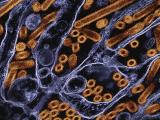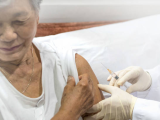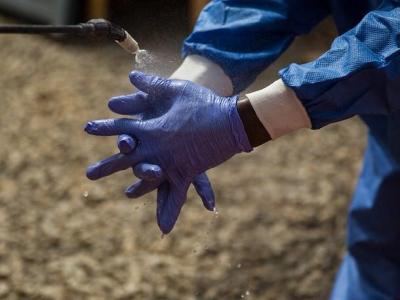May 9, 2012
H5N1 strikes Indian poultry farm
Animal health officials in India reported an H5N1 avian influenza outbreak at a district poultry farm in Tripura state, according to a May 7 report to the World Organization for Animal Health (OIE). The outbreak began on Apr 18, killing 3,168 of 4,668 susceptible birds. All domestic poultry in a 3-km radius around the outbreak site are being culled, and an intensive surveillance campaign, poultry market closure, and poultry movement ban are underway in a 10-km radius around the zone. Earlier this year, H5N1 outbreaks struck two other farms in Tripura state, which is located in northeast India and shares a border on three sides with Bangladesh.
May 7 OIE report
Expert discusses promises, pitfalls of leading flu-vaccine technology
In a review article in Vaccine yesterday, VaxInnate chairman and chief scientific officer Alan Shaw, PhD, said the world now has the means to make flu vaccines that address some of the shortcomings of the current vaccine, particularly in its performance in the elderly, but that many hurdles remain. Shaw covers the history of influenza vaccines as well as advances in mammalian cell-culture, adjuvants, insect- and plant-cell DNA, and hemagglutinin-based bacterial technology. He also discusses progress on universal vaccines based on conserved proteins and on other conserved antigens, the latest research on live-attenuated vaccines, and vaccines designed to elicit T-cell responses. He concludes, "What comes next depends on how well the candidates discussed here fare in the development process, especially in the clinic and even more so in clinical studies in the elderly where the need is greatest. A critical element for the success of any of the above programs will be new thinking on the part of the regulatory agencies regarding the metrics of success in clinical trials of these vaccine candidates." Shaw also says new vaccines must be easy to manufacture and test, which often isn't considered in early research and development.
May 8 J Infect Dis abstract
Firm wins NIAID funds for vaccine against Nipah and Hendra viruses
Profectus BioSciences Inc. announced today that it has received a $5.6 million grant from the US National Institute of Allergy and Infectious Diseases (NIAID) to develop a vaccine against the Nipah and Hendra viruses. The vaccine, called Hendra virus soluble G, is intended for use against either virus, the Baltimore company said in a press release. Nipah and Hendra are closely related Paramyxoviruses that cause often-fatal respiratory disease and encephalitis in humans and animals, the company noted. Fruit bats known as flying foxes, found in Australia, Southeast Asia, and Oceania, are the natural reservoir for the viruses, and humans can contract infections through exposure to infected horses, pigs, and bats or contaminated food. The vaccine targets the Hendra virus G glycoprotein, which mediates invasion of host cells, the company said. The vaccine was created in the lab of Christopher C. Broder at the Uniformed Services University of the Health Sciences in Bethesda, Md. Broder and his colleagues have tested the vaccine successfully in animals in Australia and the United States, according to the announcement.
May 9 Profectus press release
New Mexico reports infant pertussis death
A 2-month-old baby from New Mexico's San Miguel County died last week from pertussis (whooping cough), the state's first infant death from the disease since 2005, the New Mexico Department of Health (NMDH) said in a May 7 statement. The baby had received the diphtheria, tetanus, and pertussis (DTaP) vaccine at the regularly scheduled 2-month well child check-up, but Catherine Torres, MD, the NMDH cabinet secretary, said in the statement that infants aren't considered protected until they have received their third DTaP dose at age 6 months. Infants who get sick with pertussis infections are more likely to be hospitalized, develop complications, and die from the disease, which has prompted recommendations from health officials that people who come in contact with newborns are up to date with pertussis vaccination. The NMDH said pertussis cases in the state have paralleled a national rise in the disease, and New Mexico reported more cases in 2011 than any year since the 1980s. So far this year, 110 cases have been reported in New Mexico, including 13 in infants, of whom 8 were hospitalized. Most of the cases this year were reported from Bernalillo and Valencia counties. A 2010 pertussis outbreak in California, the state's worst in 63 years, killed 10 infants.
May 7 NMDH news release

















